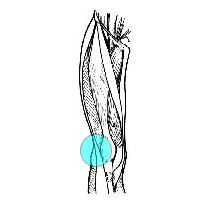Iliotibial Band Syndrome - ITBDefinition: Pain and inflammation on the outside of the knee, where the iliotibial band (a muscle on the outside of the thigh) becomes tendinous, and results in a friction syndrome by rubbing against the femur (thigh bone) as it runs alongside the knee joint.
Causes: | |||||||
| Treatment | ||||
Self-treatment:
Stop running, especially in the case of severe pain if pain is mild, then reduce training load and intensity, and avoid downhill running and running on cambered surfaces.
Take a course (5 - 7 days) of non-steroidal anti-inflammatory drugs (ibuprofen/voltaren/cataflam/mobic) available from your general practitioner or pharmacist.
Apply ice to the knee (for 10minutes every 2 hours) in order to reduce the inflammation
Self-massage, using arnica oil or an anti-inflammatory gel, to the muscle only (along the outside of the thigh). Do not massage the side of the knee where you feel the pain, as this will only aggravate the friction syndrome stretching of the ITB. Stand with the right leg crossed in the back of the left leg. Extend the left arm against a wall/pole/chair/other stable object. Lean your weight against the object while pushing your right hip in the opposite direction. Keep your right foot anchored while allowing your left knee to flex. You should feel the stretch in the ITB muscle in the right hip and along the outside of the right thigh. Hold for 30 sec. Relax slowly.
Repeat to opposite side. Repeat stretch 2 - 3 times per day.
Remember to stretch well before running
Return to running gradually
Full recovery is usually between three to six weeks
Medical treatment:
Physiotherapy, if injury doesn't respond to self-treatment in 2 to 3 weeks
Orthotist or podiatrist for custom-made orthotics to control overpronation
Orthopaedic surgeon - if injury does not respond to physiotherapy treatment, a cortisone injection into the ITB, or surgery to release the ITB may be indicated.
Alternative exercises:
Swimming, pool running, cycling (in low gear) "spinning"
Avoid any exercise that places strain onto the ITB, specifically, avoid stair-climbing
Preventative measures:
Stretching of the ITB, quadriceps, hamstring, and gluteal muscles. Hold each stretch for 30 seconds, relax slowly. Repeat stretches 2 - 3 times per day. Remember to stretch well before running.
Strengthening of quadriceps, hamstring and calf muscles.
Correct shoes, specifically motion-control shoes and orthotics to correct overpronation
Gradual progression of training programme
Avoid excessive downhill running, and cambered roads (stay on the flattest part of the road)
Incorporate rest into training programme
The BIG five - the 5 most common running injuries [ in English ]
- Achilles tendonitis
- Chondromalacia - Runner's Knee
- iliotibial band (ITB) syndrome
- Plantar Fasciitis
- Shinsplints
 Symptoms:
Symptoms:
No comments:
Post a Comment